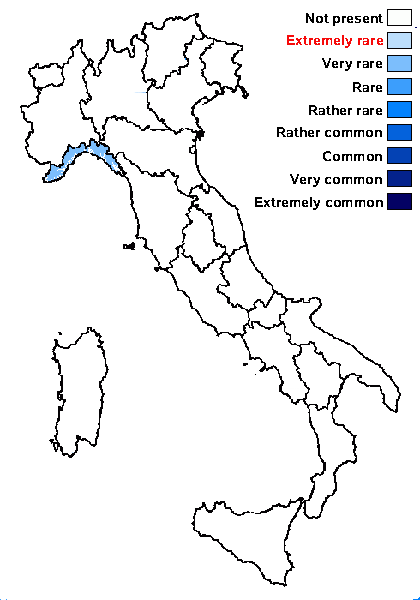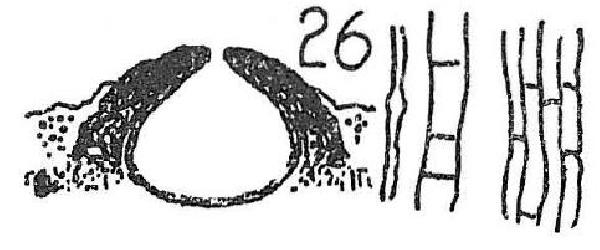Verrucaria fuscoatroides Servít
Sborn. Narodn. Mus Praze, 5, B, 9, bot. 3: 26, 1949.
Synonyms:
Distribution: N - Lig.
Description: Thallus crustose, episubstratic, areolate, 0.15-0.3 mm thick, dull grey-brown, ochre-brown or dark brown, olive-brown when wet, without a distinct prothallus, the areoles 0.3-0.7 mm wide, flat to slightly convex, with obtuse angles, separated by relatively large fissures. Cortex poorly developed, with a thin epinecral layer; medulla white to partially brownish (especially around the perithecia), but without a black basal layer. Perithecia black, 1-2 per areole, half- to ¾-immersed, the projecting part flattened to conical, 0.2-0.3 mm across. Involucrellum adpressed to exciple, reaching down at least to mid-level, sometimes to base-level, 40-60 μm thick laterally, often (but not always) 70-80 μm thick at base; exciple 0.25-0.35 mm across, the wall 15-20 μm thick, brown to dark brown; hamathecium of periphyses and periphysoids measuring 25-40 x 2-3 μm, with larger, globose terminal cells, interascal filaments absent; hymenial gel hemiamyloid, I+ red (I+ blue at very low concentrations of I), K/I+ blue. Asci 8-spored, clavate, I-, fissitunicate, the wall thickened above, with an ocular chamber, dehiscent by extrusion of an endotunica to form a delicate rostrum, Verrucaria-type. Ascospores 1-celled, hyaline, ellipsoid, 20-27(-30) x (9-)10-13(-14) μm. Photobiont chlorococcoid. Spot tests: K-, C-, KC-, P-, UV-. Chemistry: without lichen substances.Note: on more or less calciferous rocks. An apparently rather widespread, but still poorly known species described from Germany and also reported from several localities in the Austrian Alps (see Breuss 2008b).
Growth form: Crustose
Substrata: rocks
Photobiont: green algae other than Trentepohlia
Reproductive strategy: mainly sexual
Poorly known taxon in need of further study
Commonnes-rarity: (info)
Alpine belt: very rare
Subalpine belt: very rare
Oromediterranean belt: absent
Montane belt: very rare
Submediterranean belt: very rare
Padanian area: absent
Humid submediterranean belt: very rare
Humid mediterranean belt: absent
Dry mediterranean belt: absent

Predictive model
Herbarium samples
Growth form: Crustose
Substrata: rocks
Photobiont: green algae other than Trentepohlia
Reproductive strategy: mainly sexual
Poorly known taxon in need of further study
Commonnes-rarity: (info)
Alpine belt: very rare
Subalpine belt: very rare
Oromediterranean belt: absent
Montane belt: very rare
Submediterranean belt: very rare
Padanian area: absent
Humid submediterranean belt: very rare
Humid mediterranean belt: absent
Dry mediterranean belt: absent

Predictive model
| Herbarium samples |
 INDEX FUNGORUM
INDEX FUNGORUM
 GBIF
GBIF



